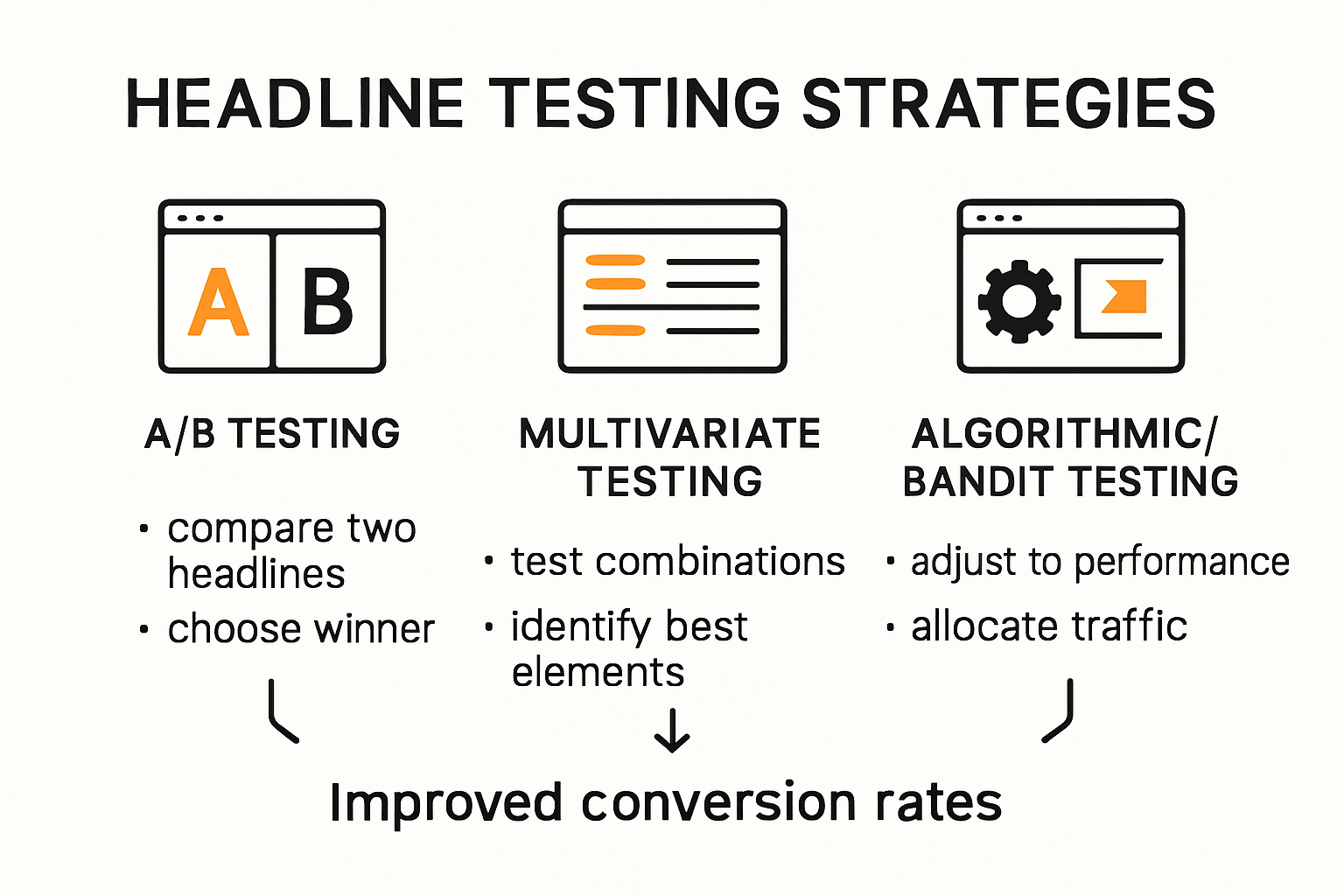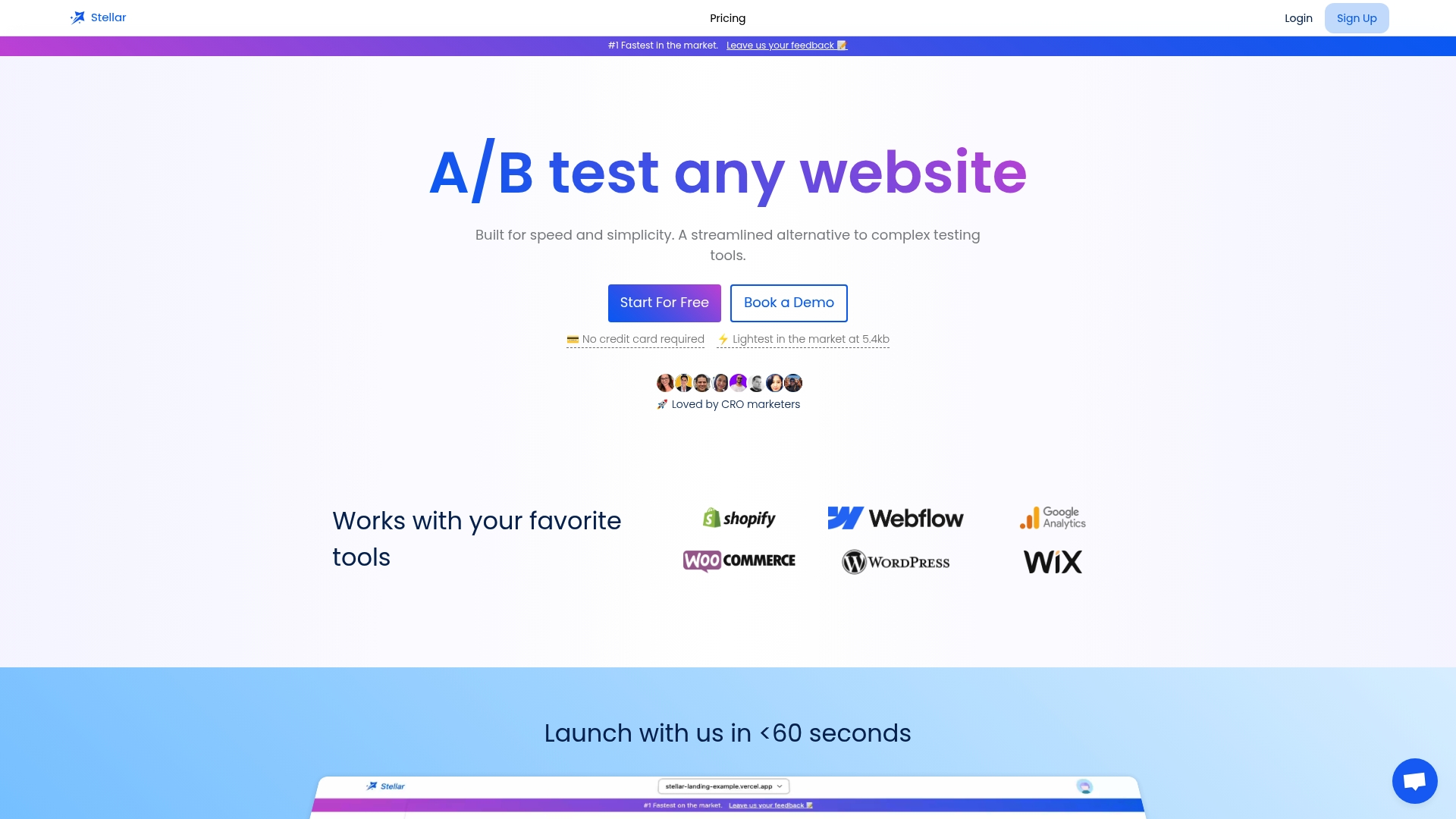
Headline Testing Strategies for CRO Marketers in 2025

Headline testing is changing fast and CRO marketers know that what works today might flop tomorrow. Think about this: advanced bandit algorithms now enhance conversion rates by up to 21 percent with real-time multivariate testing. Most marketers scramble to keep up with endless trends, but the biggest breakthroughs are happening where psychology meets data—it is no longer just about catchy words, it is about outsmarting your own assumptions.
Table of Contents
- Understanding Headline Testing Strategies
- Effective Tools and Methods for Headline Testing
- Best Practices for Analyzing Headline Test Results
- Advanced Tips to Boost Conversion Rates
Quick Summary
| Takeaway | Explanation |
|---|---|
| Headline testing is essential for CRO marketers | Systematic evaluation of different headline variations is crucial for optimizing audience engagement and conversion rates. |
| Understanding psychological triggers increases effectiveness | Effective headlines leverage curiosity gaps, emotional resonance, and cognitive ease to engage users and boost click-through rates. |
| Utilize advanced algorithmic techniques for testing | Implement sophisticated methods like multivariate testing and machine learning algorithms for dynamic optimization and better results. |
| Go beyond surface-level metrics in analysis | Evaluate multiple performance indicators such as CTR, conversion rates, and user engagement to gain comprehensive insights into headline effectiveness. |
| Adopt iterative experimentation strategies | Continuously refine headline strategies through sequential testing and adaptive resource allocation to maximize conversion rates. |
Understanding Headline Testing Strategies
Headline testing represents a critical strategic approach for CRO marketers seeking to optimize audience engagement and conversion rates. At its core, headline testing involves systematically evaluating different headline variations to determine which resonates most effectively with target audiences and drives desired user actions.

The Psychological Science Behind Headlines
Successful headline testing goes beyond mere word selection. Explore our guide on conversion optimization reveals that effective headlines tap into fundamental psychological triggers. According to research from arxiv.org, a batched Thompson Sampling method demonstrated a 3.69% increase in click rates when headlines were dynamically tested and optimized.
The psychological mechanisms driving headline effectiveness include curiosity gaps, emotional resonance, and cognitive ease. Marketers must understand that headlines serve as the first point of cognitive engagement, acting as a gateway between content and audience. Question-style and casual headlines have shown particular promise in capturing user attention. Research from ResearchGate indicates that such headline approaches can significantly raise click-through rates while maintaining audience interest.
Quantitative Approaches to Headline Optimization
Modern headline testing strategies leverage advanced algorithmic approaches. The arxiv.org research on web page optimization demonstrates how sophisticated bandit algorithms can enhance conversion rates by up to 21% through real-time multivariate testing. These methods allow marketers to move beyond traditional A/B testing, implementing more nuanced and dynamic optimization techniques.
Key quantitative strategies include:
- Statistical Significance: Ensuring test results are mathematically robust
- Sample Size Determination: Calculating appropriate audience segments
- Multivariate Testing: Simultaneously evaluating multiple headline variables
Successful headline testing requires a blend of psychological insight and data-driven methodology. By understanding audience cognitive patterns and leveraging advanced testing algorithms, marketers can craft headlines that not only attract attention but drive meaningful engagement and conversions.
To help you quickly compare headline testing methods, the following table summarizes traditional A/B testing versus advanced multivariate/bandit algorithm approaches highlighted in this section:
| Method | Key Features | Example Outcomes |
|---|---|---|
| Traditional A/B Testing | Tests two versions at a time; simple implementation | Baseline improvements in CTR or conversion |
| Multivariate Testing | Tests multiple variables/versions simultaneously | Identifies optimal combinations; more data |
| Bandit Algorithms | Real-time adaptive traffic allocation; uses ML | Up to 21% higher conversion (arxiv.org) |
| Batched Thompson Sampling | Sequential, probabilistic; updates with data | 3.69% higher click rates (arxiv.org) |
Effective Tools and Methods for Headline Testing
Headline testing demands a strategic approach that combines technological tools, analytical methods, and creative insight. CRO marketers must leverage sophisticated techniques to extract meaningful data and optimize headline performance across digital platforms.
Advanced Algorithmic Testing Techniques
Learn about our advanced testing solutions that revolutionize headline optimization. According to research from NumberAnalytics, incorporating numerical data and structured questions can dramatically enhance headline engagement. Advanced testing methods now include machine learning algorithms that dynamically allocate traffic and analyze performance in real time.
Modern headline testing strategies incorporate several sophisticated techniques:
- Multivariate Testing: Simultaneously evaluating multiple headline variables
- Contextual Analysis: Understanding audience segments and their specific preferences
- Predictive Performance Modeling: Using AI to forecast potential headline success
Data-Driven Optimization Frameworks
The blog.adoptics.com research highlights innovative approaches to headline testing that go beyond traditional A/B methodologies. Machine learning algorithms now enable marketers to create dynamic keyword insertion strategies that adapt in real time.
Key optimization frameworks include:
- Automated traffic allocation
- Probabilistic performance prediction
- Continuous learning models that refine headline strategies
Successful headline testing requires a holistic approach that blends technological innovation with deep audience understanding. By implementing advanced algorithmic techniques and data-driven frameworks, marketers can create headlines that not only capture attention but drive meaningful user engagement and conversion rates.
Best Practices for Analyzing Headline Test Results

Analyzing headline test results requires a meticulous and strategic approach that goes beyond surface-level metrics. CRO marketers must develop a comprehensive framework for interpreting data and drawing actionable insights that drive meaningful improvements in audience engagement.
Statistical Significance and Meaningful Interpretation
Explore our advanced testing methodology to understand the nuanced process of result analysis. According to research from Oregon State University, achieving statistical significance is crucial but not the only factor in headline testing success. Marketers must distinguish between statistical significance and practical significance.
Key considerations for robust result analysis include:
- Sample Size Determination: Ensure sufficient data volume for reliable conclusions
- Confidence Interval Calculation: Establish the reliability of test results
- Margin of Error Assessment: Understand potential variational factors
Comprehensive Performance Metrics
Search Engine Journal research highlights the importance of looking beyond single-dimensional metrics. Effective headline testing requires a multifaceted approach to performance evaluation. Marketers should examine multiple indicators to gain a holistic understanding of headline effectiveness.
Critical performance metrics to analyze:
- Click-through rates (CTR)
- Conversion rates
- User engagement duration
- Bounce rates
- Audience segmentation response
Advanced Analytical Frameworks
The Fibr.ai research on conversion rate optimization demonstrates the power of multivariate testing and sophisticated analytical frameworks. Modern headline testing goes beyond traditional A/B comparisons, leveraging advanced machine learning algorithms to provide deeper insights into user behavior and headline performance.
Progressive analytical approaches include:
- Predictive performance modeling
- Machine learning-driven pattern recognition
- Dynamic traffic allocation based on real-time performance
Successful headline testing is an iterative process that requires continuous learning and refinement. By implementing rigorous analytical methodologies, CRO marketers can transform raw data into strategic insights that drive meaningful improvements in content engagement and conversion rates. The key lies not just in collecting data but in interpreting it with nuance, precision, and a deep understanding of audience psychology.
Here is a table summarizing the key performance metrics and analysis factors for headline testing, as described in this section:
| Metric/Factor | Purpose/Description |
|---|---|
| Sample Size Determination | Ensures reliability of test results |
| Confidence Interval | Indicates reliability and precision of findings |
| Margin of Error | Accounts for variability in data |
| Click-Through Rate (CTR) | Measures headline-driven user engagement |
| Conversion Rate | Tracks headline impact on completed actions |
| Engagement Duration | Assesses user interest beyond the click |
| Bounce Rate | Identifies headline-audience mismatch |
| Audience Segmentation | Shows different group responses to headlines |
Advanced Tips to Boost Conversion Rates
Bosting conversion rates requires a sophisticated, multi-dimensional approach that goes beyond traditional optimization techniques. CRO marketers must leverage cutting-edge strategies that blend psychological insights, technological innovation, and data-driven methodologies.
Iterative Experimentation Techniques
Explore our comprehensive conversion optimization guide to understand advanced experimentation frameworks. According to research from arxiv.org, iterative experimentation through a sequence of randomized experiments can lead to a remarkable 20% improvement in primary performance metrics. This approach emphasizes continuous refinement and adaptive testing strategies.
Key iterative experimentation strategies include:
- Incremental Testing: Implementing small, sequential changes
- Adaptive Traffic Allocation: Dynamically shifting resources to high-performing variations
- Continuous Learning Models: Using machine learning to predict and optimize future tests
Data-Driven Optimization Frameworks
The systematic literature review from arxiv.org reveals critical insights into effective A/B testing methodologies. Most successful optimization efforts focus on collecting two primary data types: product-specific metrics and user-centric information. This dual-focused approach allows marketers to create more nuanced and precise optimization strategies.
Advanced data collection and analysis techniques include:
- Comprehensive user behavior tracking
- Granular performance segmentation
- Predictive user engagement modeling
Algorithmic Traffic Optimization
Research from arxiv.org introduces the batched Thompson Sampling method, demonstrating a 3.69% increase in click rates through dynamic traffic allocation. This sophisticated approach represents a significant leap forward in conversion rate optimization, moving beyond traditional static testing methods.
Progressive optimization algorithms leverage:
- Machine learning-driven traffic distribution
- Real-time performance analysis
- Probabilistic success prediction models
Successful conversion rate optimization is not a one-time effort but a continuous, evolving process. By embracing advanced techniques that combine technological innovation, psychological understanding, and data-driven insights, marketers can create more responsive, engaging, and ultimately more effective headline and content strategies. The future of CRO lies in adaptability, precision, and a deep understanding of user behavior dynamics.
Frequently Asked Questions
What is headline testing in CRO?
Headline testing in conversion rate optimization (CRO) involves systematically evaluating different headline variations to determine which one resonates best with the target audience, driving user engagement and conversions.
How do psychological triggers impact headline effectiveness?
Psychological triggers such as curiosity gaps, emotional resonance, and cognitive ease play a crucial role in headline effectiveness, as they engage users and significantly boost click-through rates.
What are advanced techniques for headline testing?
Advanced headline testing techniques include multivariate testing, bandit algorithms, and machine learning algorithms that enable real-time optimization and more nuanced evaluation of headline performance.
Why is it important to analyze multiple performance metrics in headline testing?
Analyzing multiple performance metrics, such as click-through rates, conversion rates, and user engagement, provides a comprehensive understanding of headline effectiveness, allowing marketers to make data-driven decisions for better results.
Outpace the Competition With Smarter Headline Testing
Are you struggling to keep up with the rapid changes in headline testing and CRO strategies? You read how algorithmic tools and real-time analytics are now essential for serious conversion growth. Many marketers face the same pain of overwhelming data, complex test set-ups, and slow website performance. Even small delays or technical barriers can mean losing the attention of your audience. Stellar offers you a way out of these frustrating cycles.

Switch to Stellar for truly frictionless A/B testing. Our platform gives you instant access to a no-code visual editor, lightweight scripts that do not slow down your pages, and dynamic keyword insertion to personalize every visitor's experience. Advanced goal tracking and real-time data mean you are never left guessing which headline truly wins. If you are ready for faster, smarter headline optimization without juggling complex tools, discover how Stellar can transform your testing workflow. Start your free plan today and see results from your next experiment before your competitors catch up.
Recommended
- Conversion Rate Optimization Strategies for Marketers in 2025
- Testing to Optimize Conversions: CRO Strategies for 2025
- SEO AB Test Strategies for CRO Marketers in 2025
- SEO Meets CRO: Testing Solutions That Boost Rankings
- Conversion-Optimierung 2025: Die besten Strategien für Marketer
- Conversion-Optimierung 2025: Mit Teststrategien zu mehr Umsatz
Published: 7/4/2025
![How To Make Ad Headlines That Get Clicks [ALEX HORMOZI]](https://i.ytimg.com/vi/kGfzLjPNsBU/hqdefault.jpg)